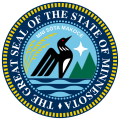| |||||||||||||||||
| |||||||||||||||||
| |||||||||||||||||
The 1883 Minnesota lieutenant gubernatorial election was held on November 6, 1883, in order to elect the lieutenant governor of Minnesota. Republican nominee and incumbent lieutenant governor Charles A. Gilman defeated Democratic nominee Randolph L. Frazee and Anti-Monopoly nominee Cornelius B. Shove. [1]


